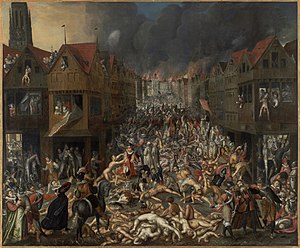51°12′48″N 4°24′10″E / 51.21333°N 4.40278°E
This article needs additional citations for verification. (August 2020) |
| Sack of Antwerp | |||||||
|---|---|---|---|---|---|---|---|
| Part of the Eighty Years' War | |||||||
 Anonymous contemporary depiction of the "Spanish Fury" in Antwerp (Museum Aan de Stroom) | |||||||
| |||||||
| Belligerents | |||||||
|
|
German and Walloon troops | ||||||
| Commanders and leaders | |||||||
|
|
Count Eberstein † Governor Compagny Marquis d’Havré | ||||||
| Strength | |||||||
| 6,000 | 20,000 (civilians included) | ||||||
| Casualties and losses | |||||||
| Unknown | 7,000–18,000[1][2] | ||||||
The sack of Antwerp, often known as the Spanish Fury at Antwerp, was an episode of the Eighty Years' War. It is the greatest massacre in the history of the Low Countries.[citation needed]
On 4 November 1576, mutinying Spanish tercios of the Army of Flanders began the sack of Antwerp, leading to three days of horror among the population of the city, which was the cultural, economic and financial center of the Low Countries. The savagery of the sack led the provinces of the Low Countries to unite against the Spanish crown. The devastation also caused Antwerp's decline as the leading city in the region and paved the way for Amsterdam's rise.